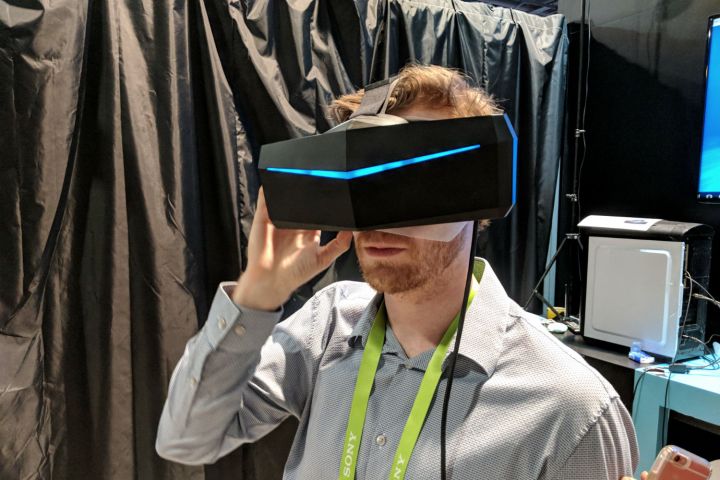
The developers behind the first “8K” virtual reality headset plan to ship the preproduction unit, aka the M1, to 10 participants in the closed beta testing group this month. If these testers give the green light, the general launch will begin in June for backers of the Kickstarter project. The team says the “8K” model will have a steady 80Hz refresh rate, while the “5K” model, also shipping in June, can reach a higher 90Hz refresh rate.
Don’t let the “8K” branding fool you — the Pimax VR headset doesn’t produce a full 7,680 x 4,320 resolution. Instead, it relies on two 3,840 x 2,160 screens, which is higher than what’ll you currently find in the Oculus Rift, the original HTC Vive, and the newer HTC Pro. Essentially, the screens combine to create a 7,680 x 2,160 viewing area with an extremely wide 200-degree field of view. Branding the device as the Pimax 4K+4K would be a marketing nightmare, and there’s currently no industry standard to correctly label VR resolutions.
Regardless of the branding, the journey to the point of finally releasing the first preproduction model wasn’t easy for the Pimax team. As previously reported, they originally targeted a January 2018 full product launch, but after five prototypes decided to explore new hardware in December 2017 to better maintain high refresh rates. To appease backers, the team said they would release a preproduction model called the M1, but even that model experienced a setback because the lenses due to arrive in February showed up late.
While the current design supports two 3,840 x 2,160 screens running at a stable 80Hz refresh rate, the team is still working on improving that number to the target 90Hz. Units shipping to Kickstarter backers may still run at 80Hz, while the 5K unit will push frames at 90Hz. Of course, these headsets don’t guarantee a VR experience running at those rates given that the overall performance falls to the parent PC’s hardware configuration, especially when you throw two 4K screens into the mix.
“Up to now, the 80Hz [refresh rate] is confirmed stable.[Eighty-two] Hz just passes the initial test standard, and now we’re trying to optimize on 85Hz and 87Hz [refresh rates]. [Ninety] Hz is the [theoretical] upper limit of the whole system,” the Kickstarter post reads. It goes on to list the 80Hz to 85Hz range as a “worst-case scenario” for the final product.
Funding for the Pimax Kickstarter project began in September 2017 and ended 45 days later, reeling in 5,946 backers pledging a hefty $4,236,618, exceeding the original $200,000 goal. The first working prototype controllers are expected to arrive sometime in June or July, followed by a general availability in the fourth quarter of 2018. Compatible lighthouses are scheduled to ship in October.
According to the team’s latest update, the upcoming Pimax headset will support games and experiences sold for the Oculus Rift. The team is also refining the head strap design and has plans for a face cushion and cooling fan. The 33-foot cable passed the internal sample test but is undergoing additional tests, they said.
Editors' Recommendations
- The world’s first 8K mini-LED monitor has arrived
- 8K gaming monitors: here’s why you shouldn’t expect them in 2023
- Apple’s first VR headset could have dual 8K displays and an eye-watering price
- Pimax 8K X hands-on review: Long-awaited 8K VR headset is here, and it’s awesome
- Gears 5 in 8K is too much to handle for Nvidia’s $2,500 Titan RTX graphics card


